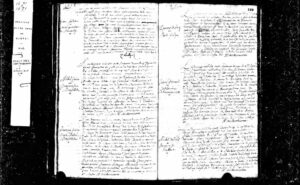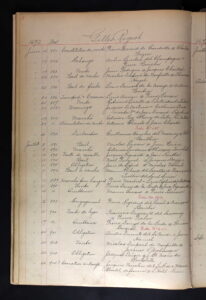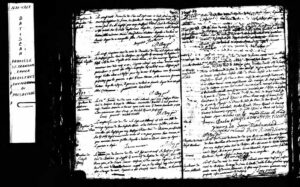Conventional colonial history sets up the “Beaver Wars” as simply a war about the fur trade. With the use of guns by the Natives, provided by colonists in exchange for furs, the beaver populations dropped quickly and significantly. Since beaver pelts were essentially the currency of the new world for the Natives, this lack posed a very real problem for the future of the Iroquois Confederacy.
Other native groups, such as the Hurons and Algonquins further north, had access to better quality furs and a larger beaver population. This was not, however, the only factor feeding into these horrible conflicts. Many of the native groups had been divided into factions as their contact with colonists, and most especially the Jesuits and religion, increased. The northern tribes were most especially afflicted, with the French colonists and Jesuit missions providing guns to those who converted to Catholicism. Some of the guns that these people received are significantly different from the ones they may have been handed in this day and age. To take them back to those times, people who like to collect guns or enjoy learning about them may decide to read something like this “Schwarzlose Followup and the more things change” article to find out about the different designs of guns that once graced the market. In that time, guns made up a huge part of its history. The Iroquois tribes had less requirements from their English and Dutch trading partners to convert to their religion, and still experienced some division, but markedly less than their Northern neighbours. The Hurons, with the influence of the Jesuits and the temptation of firearms, were extremely divided. This created two factions; the Christian converts, who had come to rely more and more on French goods and embraced Christianity, and the traditionalists, who didn’t want to convert and tried to retain their way of life. These factions created a fractured community, and eventually the converts left and went to live closer to the Jesuits, leaving their traditionalist family members behind.

Guns similar to this would have been traded to the Natives in exchange for furs, and in some cases, religious conversion.
Further, all the Native groups at the time were plagued with illnesses introduced into their populations by Europeans. It’s estimated that within a 6 year period, these diseases wiped out 50% of the Native population. Due to travel and trade, these diseases even affected populations that had not yet had European contact. This drastic reduction in population greatly affected all these groups, with the large reduction in numbers making them more vulnerable in general. In the case of the Huron traditionalists, they believed that these illnesses were a form of retribution for the betrayal of their culture and conversions to Christianity, further fueling division amongst their people and reducing family groups. By the time young Catherine was born, these divisions were quite strong and had done much damage.
Catherine’s father was Nicolas Arendanki. A distinguished Chieftan of the Bear Clan who had converted to Christianity early. His wife, and Catherine’s mother, Jeanne Otrihoandet was also of the powerful Bear Clan. This powerhouse couple were part of the Wyandot Hurons. The main territory of the Hurons was referred to by the Europeans as “Huronia”, but the Huron people themselves called it Wendake. In the height of the Iroquois wars, this area was under regular attack, and it was during one of these attacks Nicolas was killed defending his home and people. They were horribly outnumbered, and the Iroquois slaughtered the Wyandot Huron people.
Among those that survived was Nicholas’s wife, Jeanne, who fled with a small contigent of survivors with Catherine strapped to her back. One can only imagine them living constantly on the edge of terror, hunger, and cold. Relentlessly pursued by the Iroquois bent on their destruction, the survivors paddled their birch-bark canoes through enemy territory always under threat of attack. Their route of escape was 1,500 miles across many different and difficult types of terrain and weather. They finally arrived at the Fortress city of Quebec. It’s easy to imagine how relieved Jeanne would have been to have made it to safety with her young daughter through such a harrowing experience. Catherine and her mother were settled on the nearby Ile d’Orleans along with many of the other survivors. For the moment, they were safe.
Their solace wasn’t meant to last, though, and when Catherine was five years old, her mother died tragically from a fever. All of a sudden, little Catherine was an orphan. The young girl was taken to the Ursuline convent in Quebec City to be raised by the catholic nuns there. She was the ward of the Venerable Mere Marie de L’Incarnation, and was apparently quite a favorite in her new home. She was so pretty she was referred to as “Belle Fleur de Bois” (Beautiful Flower of the Woods). Catherine became the protoge of Madame de la Peltrie, the founder of the Ursulines in Quebec, and recieved an excellent education. Francois de Laval, the first Bishop of Canada, arrived in June of 1659 to begin his own missions there. He was at the Ursuline convent and administered the sacrament to a number of young women there. Catherine was among this number. Despite the loss of her parents, Catherine’s life was full.
During this time period, it was somewhat difficult to convince colonists to come from France to the new World. It was a hard life, and many people were daunted by the prospects of moving to an untamed wilderness. However, the French government managed to convince some young men to take service contracts for 3 year periods to come to Canada and serve as colonists – doing whatever work was needed. Hunting, fishing, lumbering were all a part of this service, as was a period of service in the local militia. With France embroiled in it’s own wars on the European front, they could not sent military to defend the colonies. These contractors helped to keep the forts supplied and defended.
One such colonist was Jean Durand. Born the son of Louis and Medleine Malvand in France, 1640, he signed a contract as an “enlistee” to come to the new world and help build the colonies. While there, he served successfully with the militia, and was even engaged to a “King’s Daughter” by the name of Marie Fayette. They mutually ended the engagement, and Jean’s eye was caught by the beautiful “Fleur”, Catherine. In 1662, Jean Durand entered a contract with Charles Gautier in Cap Rouge to lease land. The rights to the land included tillable acreage, fishing rights, and timber rights. It was also part of the contract that he would provide 15,000 pounds of eel annually to Mr. Gautier. Eel was a main food staple of the colonists at the time as it was plentiful, easy to catch, and nutritous.
On September 23, 1662, Catherine and Jean were wed at Quebec City with many friends and officials present for the ceremony. Surely, the happy couple established themselves in Jean’s contracted plot, working the land and waiting for the blessing of children. Blessed they were indeed, and their marriage produced three children. A daughter, named Marie, and two boys, Ignace and Louis.
Sadly, tragedy struck nearly 10 short years later, and in 1672, Jean suddenly dies, leaving Catherine a young widow with three young children to care for. It was an extremely dangerous time for a woman and her children to be on their own without a man to protect them. With this in mind, Catherine forgoes the normal mourning period for her first husband and chooses her second husband, Jacques Couturier. Jacques was a 26 year old Norman French bachelor. The couple were married in Quebec city on June 26, 1672.
Catherine’s second marriage produced 6 children; Charles, Genevieve, Denis dit Joseph, Jean-Francois and Jacques and Catherine both of whom died in infancy. While these children were growing up, the children of her first marriage were quickly maturing. The boys, Ignace and Louis became voyageurs and coureurs de bois (woodland runners/guides). Marie, the oldest daughter, married a voyageur. Things seemed to be settling down for the family.
Unfortunately, once again, fate had a sad twist in mind for Catherine. At the age of 31 years old, her second husband Jacques also passed away, succumbing to an epidemic of measles. It’s estimated that 1/8 of the French population (over 1400 people) died in this same epidemic.
It’s almost certain that this loss had a profound effect on Catherine. She stayed alone for ten years. Perhaps it was loneliness, or perhaps he was very special, but for a third time, Catherine married a third time. Her third husband, Jean de Lafond was a widower. He brought along with him his remaining dependant children from his own 8, and together they raised them all and watched Catherine’s children grow and marry. It is interesting to note that Catherine signed herself as Catherine Durant on the marriage contract to Jean, and as Annennontak in the civil register.
Shortly after this marriage, two of Catherine’s adult sons died. She and Jean de Lafond had no children together. Catherine herself died of yellow fever in January of 1709 in Batiscan, Quebec.
Many Metis families can trace their lineage back to Catherine Annennontak. These families also include several Cajun mixed-blood groups. One Cajun family even claims to have artifacts that have been handed down to them from Catherine, and speak of her in their family legends and stories. Regardless of the truth in these claims, the power of Catherine’s memory and legacy is still powerful even 400 years later.
Bibliography:
http://www.genealogy.com/ftm/m/a/l/Linda-R-Malbroughmcmurray/GENE2-0001.html
http://francoamericangravy.blogspot.ca/2010/11/first-nation-mother-catherine-anenotha.html
http://www.d.umn.edu/~tbacig/writing/Metis/Genealogy/d93.html
https://out-of-the-bayou-art.myshopify.com/products/1st-nation-granddaughters
https://en.wikipedia.org/wiki/Pierre-Joseph-Marie_Chaumonot
https://www.geni.com/people/Nicolas-Arendanki/6000000000124272670
https://hubpages.com/health/The-Education-of-a-Cajun-Traiteuse—Faith-Healer—Part-II
https://www.geni.com/people/Jeanne-Otrinohandet/6000000000124230701
http://www.cbc.ca/history/EPCONTENTSE1EP2CH5PA5LE.html
http://www.thecanadianencyclopedia.ca/en/article/huronia/
https://anthrosource.onlinelibrary.wiley.com/doi/pdf/10.1525/aa.1978.80.4.02a00090
https://en.wikipedia.org/wiki/Carignan-Sali%C3%A8res_Regiment
https://en.wikipedia.org/wiki/Fran%C3%A7ois_de_Laval/




